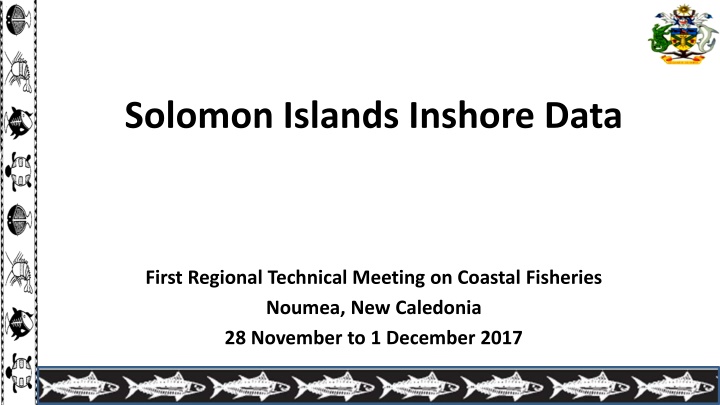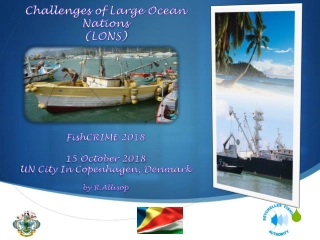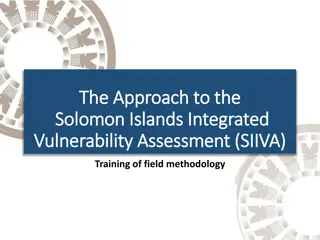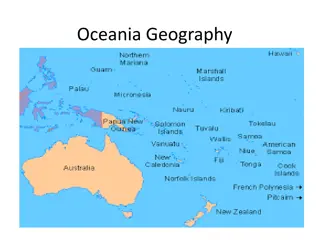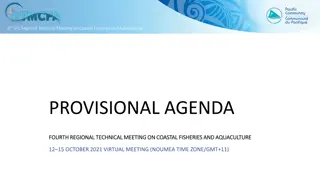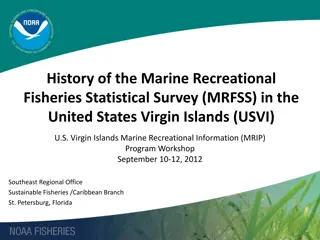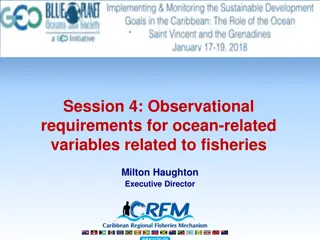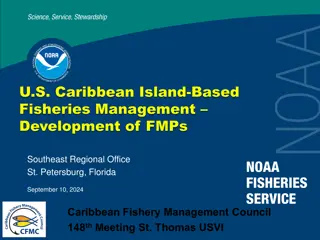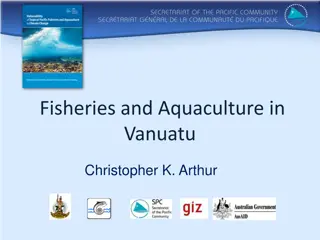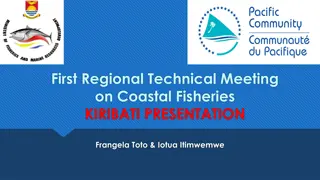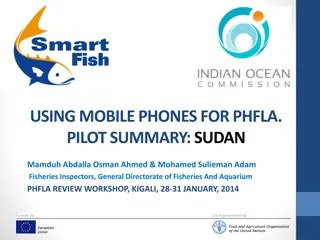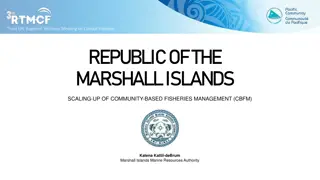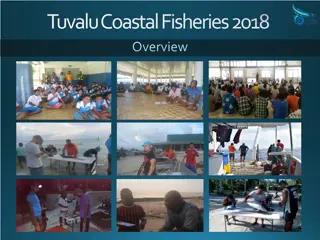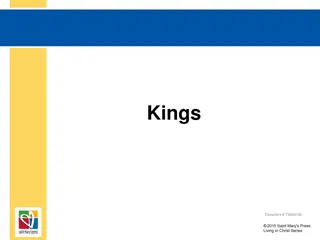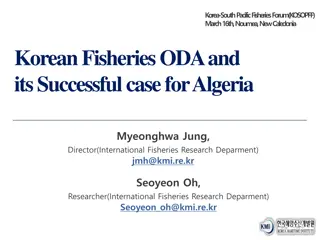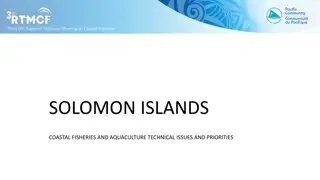Insights into Data Collection and Fisheries Management in Solomon Islands Inshore Fisheries
Through a comprehensive overview of data collection methods and types related to inshore fisheries in the Solomon Islands, this report highlights various aspects such as marine product export and local purchase data, HAPIFIS data collection with socio-economic surveys, and research on key species like coconut crabs and crayfish. The process of data collection, including license applications, market surveys, and on-site assessments, is detailed, emphasizing the importance of accurate data for sustainable fisheries management.
Download Presentation

Please find below an Image/Link to download the presentation.
The content on the website is provided AS IS for your information and personal use only. It may not be sold, licensed, or shared on other websites without obtaining consent from the author.If you encounter any issues during the download, it is possible that the publisher has removed the file from their server.
You are allowed to download the files provided on this website for personal or commercial use, subject to the condition that they are used lawfully. All files are the property of their respective owners.
The content on the website is provided AS IS for your information and personal use only. It may not be sold, licensed, or shared on other websites without obtaining consent from the author.
E N D
Presentation Transcript
Solomon Islands Inshore Data First Regional Technical Meeting on Coastal Fisheries Noumea, New Caledonia 28 November to 1 December 2017
TYPES OF DATA COLLECTED FOR INSHORE FISHERIES 1. Marine Product Export Data 2. Marine Local Purchase Data 3. HapiFis Data Market survey Invertebrate survey Socio economic survey 4. Aquaculture Data 5. FAD Monitoring Data 6. Research & Survey Data corals, sea-cucumber, trochus, finfish, etc
HOW DATA IS COLLECTED 1. Licence Application Form 2. Licence paid, Receipts issued ( SIG Receipts) 3. On site Assessments and Surveys 4. Market surveys 5. Creel surveys
MARINE PRODUCTS EXPORT DATA 1. Companies must have Licence before exporting any marine products 2. Applicants lists types of marine product of interest 3. Applicant pays licence fee for each type of product. 4. Export Permit Forms is use to record marine product name, quantity, value, destination, etc. 5. MCS officers checks the consignment to ensure compliance with fisheries regulations
MARINE PRODUCT PURCHASE DATA Marine purchase form are submitted by exporter at the end of year Forms has details ( products purchased, locations-province, island, village)
HAPIFIS DATA Contracted data enumerators use tablet with android designed forms to collect, prices, fish species and quantity. Biological data - length frequency , weight and fish species, fish species, gonad and photos of fish Socio economic data Market survey - price, quantity , species are uploaded via tablet into the database hosted at telekom.
HAPIFIS DATA Research team collected data on 3 main species 1. Coconut crab 2. Crayfish 3. Mud-crab Survey questionnaires cover market, hotels and restaurants Hotels/restaurants were given record books to fill and research staff monitors and collect data regularly for entry. Hotels are interested only on crayfish tails.
SOCIO-ECOMONIC DATA The proportion showed that fishing activity is high in Choiseul, Isabel, Western and Malaita Challenge Useful data on socio economic data needs to stored proper database system. It would be better that all data related to inshore fisheries are centralised for easier access.
AQUACULTURE DATA Designed form to record application for aquaculture projects. For example: Seaweed, Tilapia, Milkfish, Prawn Purpose is to monitor all applications, assessment of the project , not approve, approve and continue to liaise, monitor, projects that qualifies to ensure that farmers receive needed support for their project. Data covers project name, type of aqua - marine or freshwater, type commodity, who owns it (individual, family, community, company, date project submitted, type of assistance needed, estimated coast, assessment , approval or not, status of fundings
FAD MONITORING DATA Catch and Effort data Position and status of the FAD Storage of this data is in the WorldFish ReefBase Database
SYSTEMS USED TO STORE DATA 1. Solic Database, 2. backend sql 2008r2 and front end Microsoft access , multi-users access on the sig network. 3. The database is stored on SIG-ICTSU server. HAPIFISH DATA 1. ICTSU server- market survey data price , species and socio economic data 2. MS Access on standalone laptop at office . - fish photos, measurement, weights 3. Excel spread sheet - catch by species
SYSTEMS USED TO STORE DATA AQUACULTURE DATA 1. Excel spread sheet FAD DATA 1. WorldFish Reef Base Database 2. Excel spread sheet INVERTS AND FINFISH DATA 1. SPC Database (RFID) 2. Excel spread sheet
CHALLENGES (Export and Local Purchase data) 1. Often the form is not properly filled, missing names of village, islands, ward, duplicate names of villages, difficult to identify correct village. 2. Quantity purchased for export does not much the export quantity. 3. Purchase forms need revising to capture required data 4. Export permit forms to include CITES permits (Link to Ministry of Environment)
CHALLENGES (HAPIFIS DATA) Transferring data via sig network from provinces proved difficult. Loss / breakdown/cost of maintenance of tablets are real issues Difficult to access the raw data, difficult to link the biological data collected to the photos of fish species.
CHALLENGES (AQUACULTURE DATA) Improve database system to house these data is the way forward CHALLENGES INVERTEBRATE DATA These data are stored only in excel speadsheet. If more data are collected then proper database system to store these data may be required.
PRIORITIES 1. Develop of Inshore Fisheries Database. CBRM data Provincial Fisheries Centers data 2. Linking our MFMR database with MECDM especially for permitting CITES products. 3. Capacity building for our exporters, fishers, and MFMR staff. - on how to fill up forms - analysis of data - collection of data 4. Export Data Bechedemer fishery Prices, sizes, pieces/1kg weight
